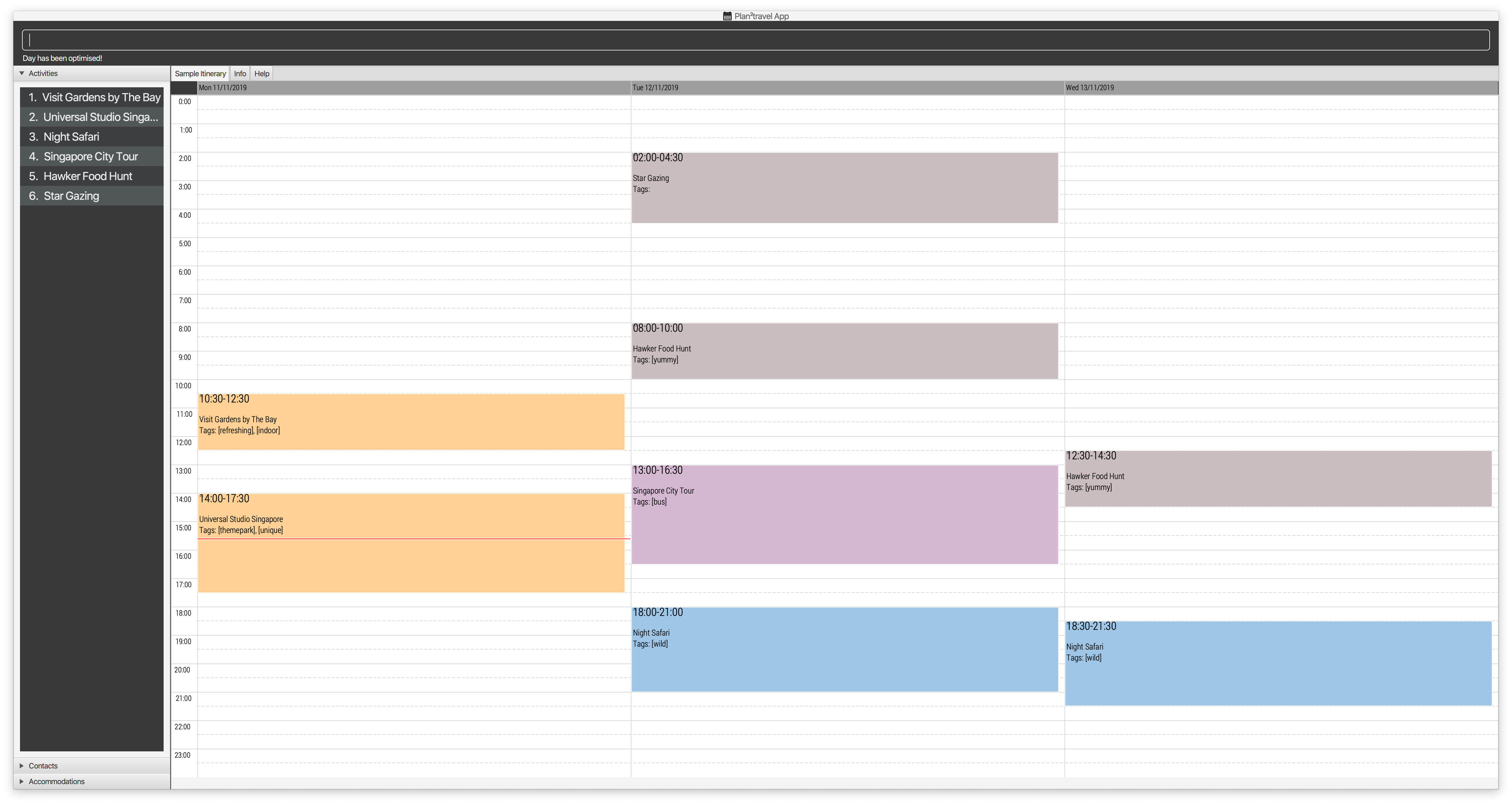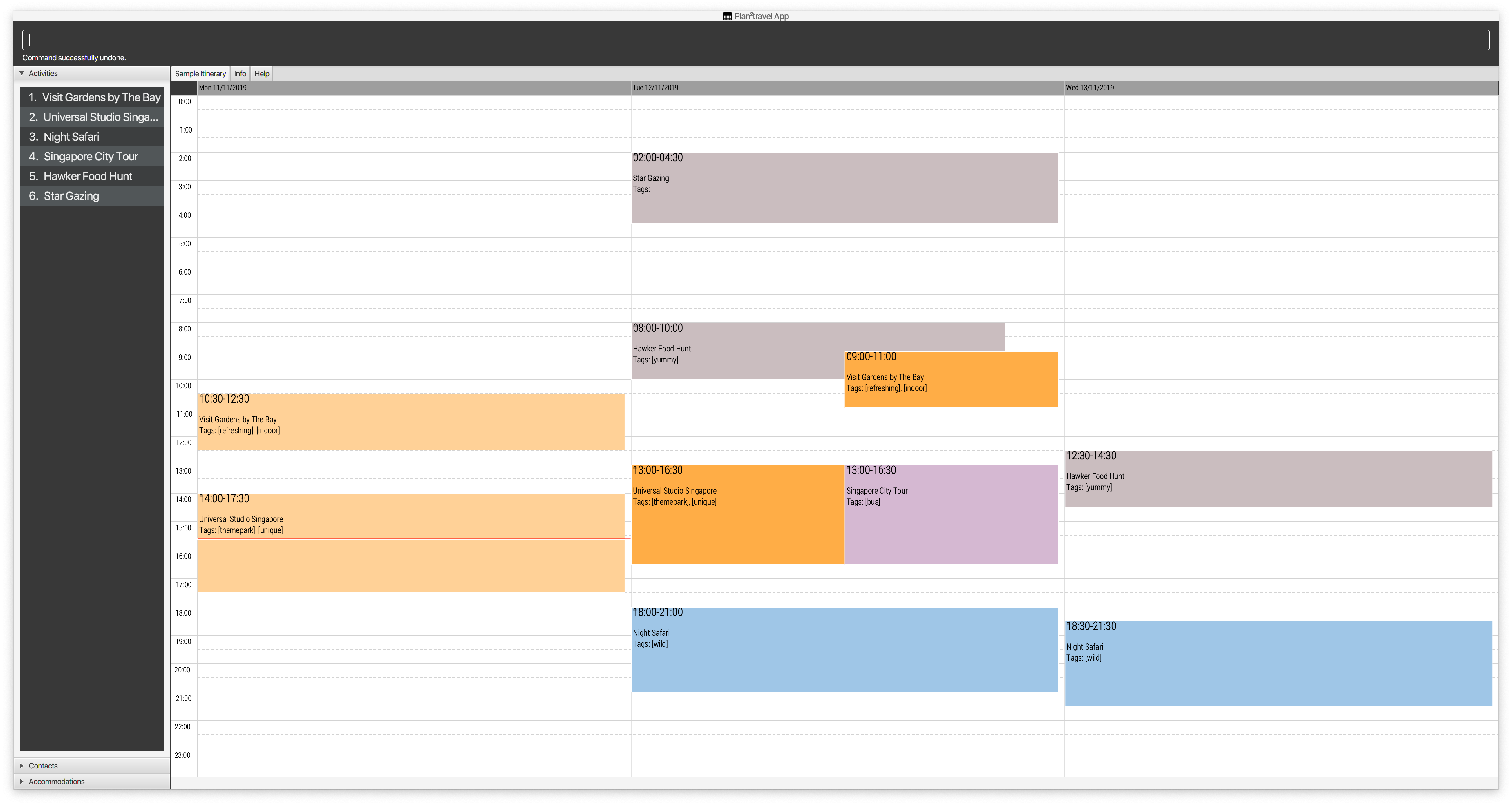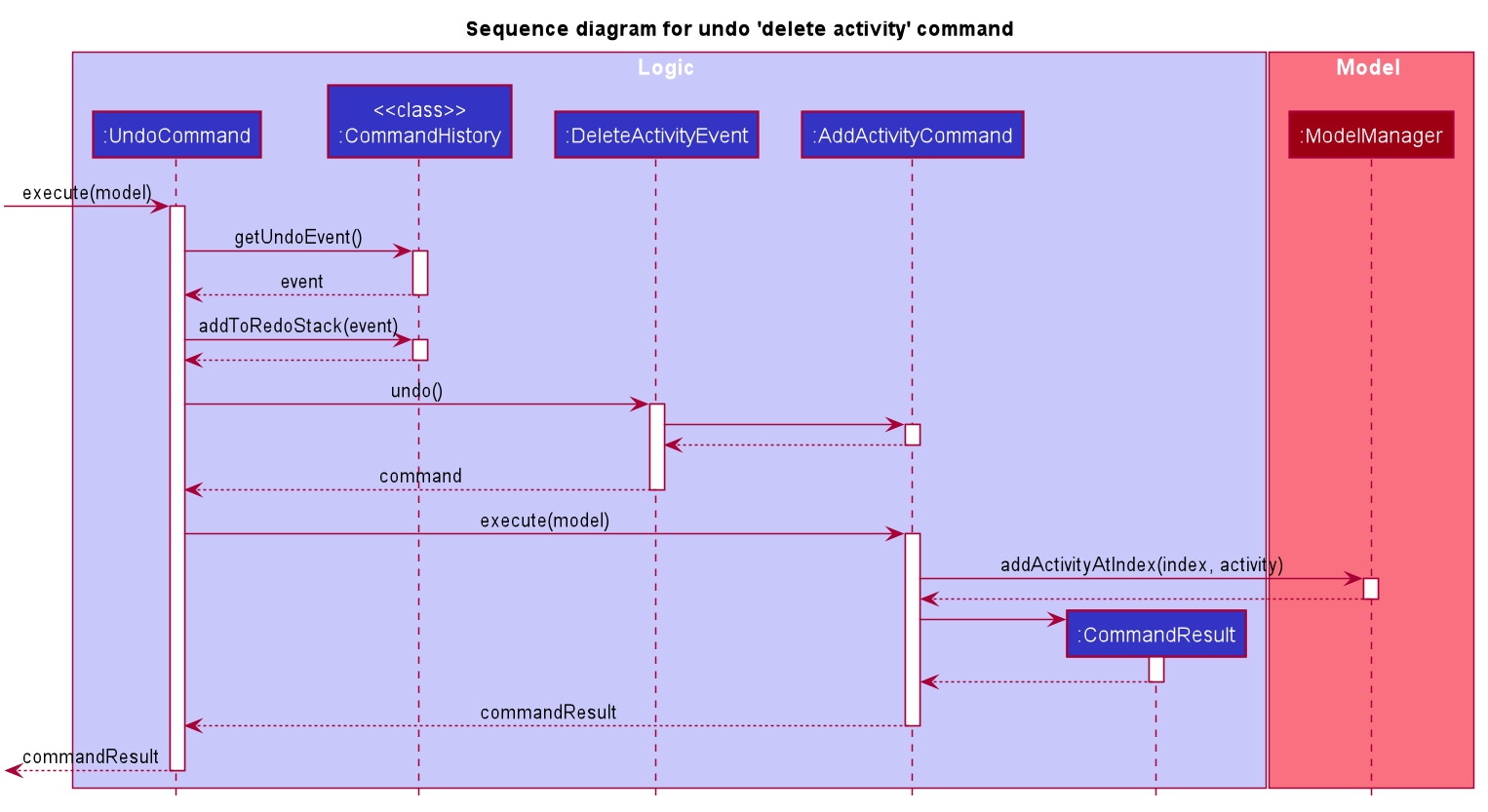PROJECT: Plan²travel
The purpose of this document is to document the contribution that I have made in the project: Plan²travel as a student undertaking the module CS2103T under NUS School of Computing.
Plan²travel Github link: https://ay1920s1-cs2103t-t09-1.github.io/main/
1. Introduction
Plan²travel is a desktop travel planning application. The application is targeted at fellow university students who
travel infrequently and would greatly benefit from an application that helps organize their travelling information when they plan their own itinerary. Plan²travel has the ability to store and display information such as activities, accommodations, contacts and an itinerary which comprises of a list of day. Each day is displayed with a list of activities that is scheduled.
The user interacts with the application using a Command Line Interface (CLI), and it has Graphical User Interface GUI created with JavaFX.
It is cross-platform and can be compiled for both Windows and Mac OS.
Below is a screenshot of our application:

2. Summary of contributions
Below is a summary of the contributions that I have made to the project. |
2.1. Major enhancement:
-
Added the ability to undo/redo previous commands
-
What it does: allows the user to undo all previous commands one at a time. Preceding undo commands can be reversed by using the redo command.
Only undoable commands can be undone by the 'undo' command. -
Justification: This feature improves the product significantly because a user can make mistakes in commands and the app should provide a convenient way to rectify them.
-
Highlights: This enhancement affects existing commands and commands to be added in future. It required an in-depth analysis of design alternatives. The implementation too was challenging as it required changes to existing commands.
-
-
Functional Code Contributed: Update 1 | Update 2 | Update 3 | Update 4 | Update 5 | Update 6 | Update 7 | Final Update
2.2. Minor enhancement:
-
Morph original code base for Model and Storage package
-
What I did: I modified the entire model package from the original code base and added new model class files, such as Accommodation, Activity and Contact. I also remove traces of unused codes from the previous code base. Aside morphing model, I also morphed the storage package, allowing the application’s data to be saved into 4 different json data files instead.
-
Justification: Morphing has to be done to the old code base in order to fit the goals of our application. Once the code base is morphed, the team is able to proceed with implementing their individual features of the application.
-
Highlights: I gained a deeper understanding of how the different components of the code base worked, especially for storage component. With the insights gained, I was able to advise my teammates on how they should approach their implementations when working with these components.
-
-
Functional Code Contributed: Update 1 | Update 2 | Final Update
-
Test Code Contributed: Test
2.3. Other Contributions:
-
Tools:
-
Set up build tools for maintaining and automation of team repository. travis, appveyor, coverall
-
-
Documentation:
-
Contributed to the User Guide and Developer Guide for this project. See below for more details.
-
-
Community:
-
Over 30 Pull Requests on Github
-
Over 15 Reviews on Github
-
Overall Code Contribution here
3. Contributions to the User Guide
Given below are sections I contributed to Plan²travel User Guide. They showcase my ability to write documentation targeting end-users. |
3.1. Undo: undo
Allows the user to undo by one action. Only Undoable commands executed previously can
be undone. Refer to the list below for all possible undoable commands.
Format: undo
List of UndoableCommand:
add activity/ accommodation/ contact/ days |
delete activity/ accommodation/ contact/ day |
edit activity/ accommodation/ contact |
schedule |
unschedule |
autoschedule |
optimise |
clear |
3.2. Redo: redo
Redo by one action. This command is to revert the changes of the latest undo.
Format: redo
| redo command can only be called after undo. |
The 4 screenshots below demonstrates the Undo/Redo command when the user executes optimise budget command.
-
Before executing 'optimise'

-
After executing 'optimise 2'

-
After executing 'undo'

-
After executing 'redo'

4. Contributions to the Developer Guide
Given below are sections I contributed to the Developer Guide. They showcase my ability to write technical documentation and the technical depth of my contributions to the project. |
4.1. Undo/Redo feature
The undo command allows user to undo by one command (if the command is undoable).
The redo command allows user to return to the original state before latest undo.
4.1.1. Implementation
The undo/redo feature utilizes various classes to operate, such as CommandHistory class and the
classes within the events package in the logic component.
CommandHistory is a static class that contains the undoEventStack and redoEventStack of the application, each containing Events.
KEY IDEA:
Event — Every UndoableCommand can be wrapped into its own unique Event. |
List of UndoableCommand:
add activity/ accommodation/ contact/ days |
delete activity/ accommodation/ contact/ day |
edit activity/ accommodation/ contact |
schedule |
unschedule |
autoschedule |
optimise |
clear |
Step 1. The user executes an UndoableCommand.
Step 2. The UndoableCommand is executed, generating an Event in the process.
Step 3. EventFactory will parse the UndoableCommand to generate an Event.
(eg. DeleteActivityCommand will result in DeleteActivityEvent generated)
| EventFactory is a static class that will parse an UndoableCommand and generate the corresponding Event. |
Step 4. Event is added to undoEventStack stored in CommandHistory. The redoEventStack in
CommandHistory is also cleared upon generating a new Event.
Step 5. The UndoableCommand has been executed, returning a CommandResult to be shown.
Step 6. To undo the previous UndoableCommand, the user executes undo command. An UndoCommand is generated.
Step 7. UndoCommand is not an UndoableCommand. Executing the UndoCommand gets the Event from the top of undoEventStack
and calls the undo method of Event.
| Both UndoCommand and RedoCommand are not UndoableCommands, no Events are generated. |
Step 8. The Event is popped from the undoEventStack and pushed to redoEventStack in CommandHistory. A CommandResult
is returned and the Event is undone.
Step 9. To redo the command that has been undone, the user executes redo command. A RedoCommand is generated and it
is not an UndoableCommand. This execution is similar to steps 6 and 7, except Event is popped from redo stack instead and pushed to undo stack.
The following two sequence diagrams shows how the user’s input is handled for 'delete activity 1'.
The first diagram below shows the execution of 'delete activity 1' command. It shows how the Event is generated and how the
undoEventStack and redoEventStack is updated.

When DeleteActivityCommand is executed, it generates the activityToDelete by extracting the Activity to be deleted from
the Model’s list of activities based on the index specified in user’s command input. It then calls the Model’s
deleteActivity method.
|
The second diagram below shows the execution of undo command. Executing UndoCommand calls undo of the DeleteActivityEvent,
which returns an AddActivityCommand with the Activity (initially deleted) to be added back at the correct index.
Both Activity and Index were stored in DeleteActivityEvent.
This new AddActivityCommand is executed, and the DeleteActivityCommand is successfully undone.

Each Event stores the necessary data required by the reverse Command to undo the effects of the initial
UndoableCommand.(eg. AddActivityEvent stores the Activity added, as DeleteActivityCommand requires the Activity to undo
the initial AddActivityCommand’s changes)
|
The following activity diagram summarizes what happens when a user executes an UndoableCommand, an UndoCommand, a RedoCommand, or any other Commands.

|
If the user does not execute an UndoableCommand, UndoCommand or RedoCommand, the stack of Events in CommandHistory will not be affected. (eg. view, list commands) |
4.1.2. Design Considerations
Aspect: How undo & redo executes
-
Option 1 : Wrap every UndoableCommand in an Event class, which has undo and redo methods.
-
Pros:
-
Uses less memory by storing Event objects rather than storing every state of the Model.
-
Convenient for future extensions for new Commands added. Just need to ensure for every UndoableCommand, there must be a Command that is able to undo its changes.
-
Command classes obey Single Responsibility Principle, they do not need to know how to undo or redo itself, as it is abstracted to their corresponding Event classes.
-
-
Cons:
-
Every UndoableCommand requires another Command to undo its changes. Might be difficult to manage if more UndoableCommands are added.
-
-
-
Option 2 : Saves the entire Model data (comprising of accommodations, activities, contacts and days).
-
Pros:
-
Easy to implement.
-
-
Cons:
-
May have performance issues in terms of memory usage. Expensive to store the various objects at every state.
-
-
Aspect: Data structure to support the undo/redo commands
-
Option 1 (current choice): Use of static class CommandHistory to store a stack of Events to undo, and a stack of Events to redo.
-
Pros:
-
Easy to implement and understand. Every Event object is generated through EventFactory and stored in CommandHistory.
-
-
Cons:
-
Static class is used instead of Singleton implementation. No single instance of CommandHistory is created, cannot be passed as a parameter to other methods and treated as a normal object, hence might pose a difficulty during extensions.
-
-
-
Option 2: Create a HistoryManager class to store a single list of Model objects for undo/redo
-
Pros:
-
Straightforward and easy implementation, storing a deep copy of Model whenever an UndoableCommand is executed.
-
-
Cons:
-
Need to keep track of the Model object obtained from the list to set during Undo/Redo. Difficult to manage the pointer in the list.
-
-